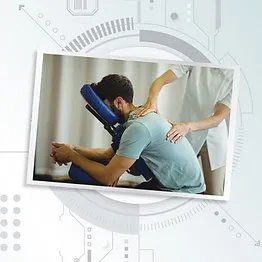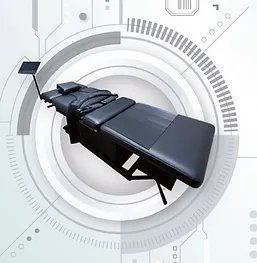Frozen Shoulder
Pain Symptoms
Headache Symptoms
Shoulder & Neck Pain
Spine & Joints
- Disc-herniation
- Scoliosis
- Sciatica
- Back Pain
- Ankylosing Spondylitis
- Osteoporosis
- Pregnancy Pain
- Bone Spur
Upper Limbs
Lower Limbs

When shoulder stiffens
Also known as adhesive capsulitis, frozen shoulder typically presents as pain and stiffness of the shoulder that begins slowly but gets progressively worse. Pain or stiffness with internal rotation, such as placing your hand on your low back, is often the first complaint of patients suffering from frozen shoulder.
The stiffness may make it difficult for you to do everyday tasks, such as driving, dressing or sleeping. You may also have difficulty scratching your back or putting your hand in your back pocket.
The pain usually comes on gradually, and is often worse when you move your shoulder joint. It may also be worse at night.
Signs and symptoms
The most obvious symptoms are pain and joint stiffness which may lead to insomnia. Patients cannot perform actions like raising hands, combing hair, wearing clothes and hand behind back.



Frozen shoulder self-test
The early symptoms of a frozen shoulder are not obvious. If patients experience shoulder pain, they can first perform a frozen shoulder self-test to examine the range of motion of the affected shoulder joints. If they cannot raise their arms above their head, or cannot reach behind their back, they are likely to suffer from a frozen shoulder. Seek early medical attention to facilitate treatment and reduce the pain and its impact on daily life.
Examination for early treatment
Spine and Physiotherapist will do an examination of the shoulder and the spine determine if the diagnosis is frozen shoulder. The range of motion will be tested laterally raising the arm to the side and raising the arm forward in the sagittal plane. Raising the arm to the back is not as restricted or as noticeable for the patient.
What causes frozen shoulders?
Frozen shoulder may be idiopathic. The exact reason why frozen shoulder develops is not known at present. It’s thought to be caused by inflammation of your shoulder joint and its surrounding capsule. Frozen shoulder can sometimes develop if you have had a shoulder injury, such as a fracture, or if you have had surgery on your shoulder.
How to release a frozen shoulder?
After the examination, the Spine and Physiotherapist may adjust the spine and then the shoulder.Some of the frozen shoulder adjustments may be painful if no anesthesia is used, even though Spine and Physiotherapy adjustments in general are not painful.
However, adjustments for frozen shoulder will give the greatest amount of correction in the first visit. A short and sharp increase in pain may be felt directly after the adjustment, but the pain will calm down in a few minutes. After the pain subsides, the Spine and Physiotherapist will again test the range of motion, which can improve as much as 50% or more after the first visit with certain Spine and Physiotherapist.
Typically, the pain will be less severe than before the adjustment. The Spine and Physiotherapist will then recommended some exercises, which will also improve the effectiveness of the Spine and Physiotherapy adjustments.
1. Shoulder pain is most often caused by subluxations in the neck. Neck pain and stiffness is commonly associated with this condition confirming the neck problem. Without treating the cause adequately, often in the neck, NECK PAIN TREATMENT, all other treatment options are slow and dependent on the body's natural recuperative powers.With no treatment at all this condition usually resolves within three years, owing to this natural healing power of the body.
2. Movement. The worst treatment of this condition is immobilisation, as in a sling. It rapidly worsens the pain and stiffness. A gentle set of stretches for the FS, done frequently, numerous times a day, is an essential part of the Spine and Physiotherapy care. As the movement returns, and the pain lessens, active rehab exercises, ROTATOR CUFF STRENGTHENING are essential.
3. Key to shoulder treatment is mobilisation and/or adjusting the Acromio Clavicular joint. The earlier the diagnosis is made and start treatment, the better the prognosis would be. Patients should comply to the treatment protocol so as to maximize the treatment effects.
Prevention of frozen shoulder: fewer loads and more exercises
Although middle-aged people are the high-risk group for frozen shoulders, it does not imply an inevitable middle-age condition. Prevention is better than cure. We can begin by altering our everyday life habits to prevent frozen shoulders, such as changing our working posture frequently and doing adequate exercises to arrange enough activity volume and rest for our shoulders.
- People who often sit in front of the computer should change their posture every 15 minutes and take a break every 45 minutes to let the joints rest.
- When doing housework, do not focus on or repeatedly use one arm and use two arms in turn.
- Use trolleys to lift heavy loads to reduce pressure on shoulder muscles.
- When reaching an object on a high shelf, avoid raising your arms too much and use a stable step stool to help.
- Sleep on your back and avoid sleeping on your side for too long to reduce pressure on the shoulders.
- The cause of a frozen shoulder is also associated with the temperature. Wear more clothes if the weather is cold or if you sit near the air-conditioner.
- Stretching exercises such as yoga and Tai Chi, as well as moderate upper limb strengthening exercises including swimming, basketball, volleyball and badminton, etc., can effectively prevent frozen shoulders.
Frozen shoulder FAQ
What should I avoid doing with a frozen shoulder?
Although keeping your shoulders active is essential for their recovery and rehabilitation, you should still avoid using them in pulling or fast movements. These movements will only exacerbate the pain and exert more pressure on the muscles.
How to ‘thaw’ a frozen shoulder?
Sit or stand upright, lift the affected arm at the elbow with your other arm and bring it across your body. Exert light pressure to stretch the shoulder. Hold for 15 to 20 seconds. Repeat 10 to 20 times every day.
Can I massage a frozen shoulder?
Massage, stretching and physiotherapy are particularly effective in the treatment of a frozen shoulder. Massage helps to relieve tension and stiffness in the muscles to let them relax. This can restore shoulder mobility and improve function, and may also manage the blood flow to the affected area to reduce inflammations.
Should I treat a frozen shoulder with heat or cold?
A frozen shoulder responds better to cold than heat.
Is a frozen shoulder permanent?
A frozen shoulder can be permanent without active treatment. Physiotherapy for a frozen shoulder includes ultrasound, electrical stimulation, exercises to restore range of motion, ice packs and strengthening exercises.



